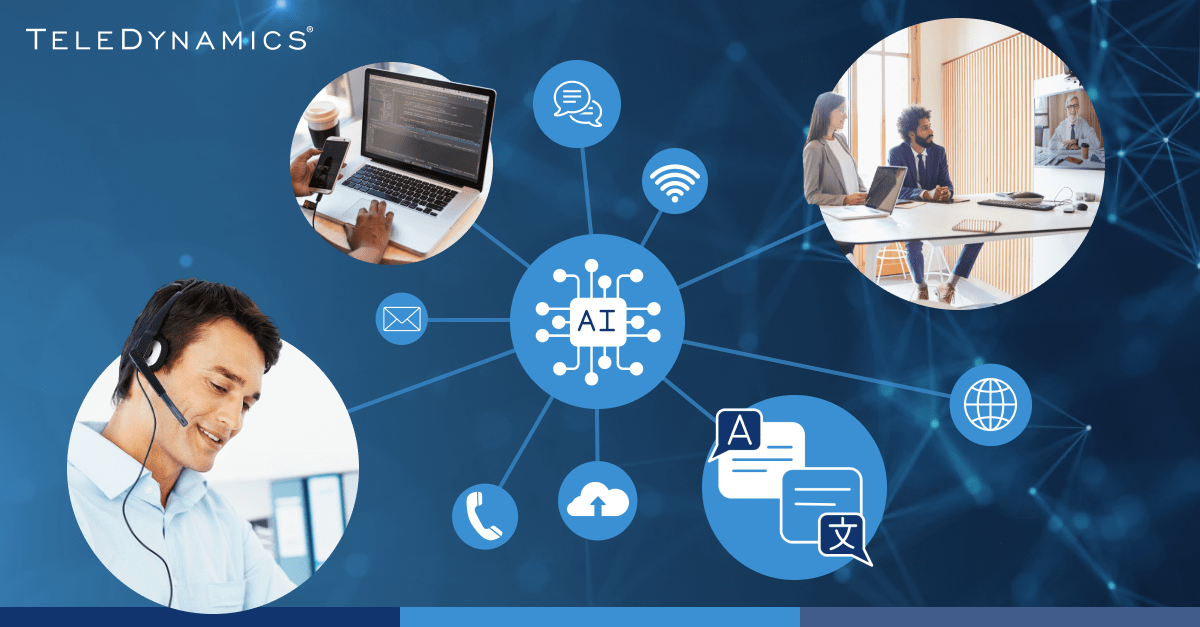
The arrival of ChatGPT has propelled AI into the mainstream. It is a tool that allows anyone to use AI technology and has thus dramatically increased broad exposure to and understanding of artificial intelligence.
Of course, AI is about much more than simply writing prompts and examining text responses. For unified communications (UC) systems, AI is poised to add massive value to an already innovative and versatile set of applications, ultimately launching UC into a realm of new capabilities.
This article examines how AI is expected to shape numerous aspects of UC technology and related systems in the near and not-so-near future.
AI and the future of UC
In several past articles, we investigated how VoIP and AI are revolutionizing communications, and we more specifically examined the role that tools like ChatGPT will play in business communications applications. These articles focused on how people may incorporate AI into "communications-oriented" features such as automated assistants, intelligent call routing in contact centers, and real-time translation systems.
These application scenarios are intuitive and constitute the expected next steps in delivering UC services to end users. They add AI's capability to existing functions, greatly enhancing them.
However, UC today results from the convergence of multiple technologies beyond simple voice or video. UC includes messaging, collaboration, and content-sharing capabilities, which may leverage other applications, such as CRMs, calendar and scheduling programs, and webinar platforms.
Many services, in turn, deliver specialized in-meeting apps that allow for deeper user interaction, such as polls, question-and-answer apps, automated transcription tools, meeting minutes generators, and report creators.
AI is excellent at identifying patterns from real-time events, human behavior, and data gathered before, during, and even after a UC session has ended. Incorporating AI into these UC functions will offer unprecedented automation, insight, and efficiency, uncovering even more new ways to use UC.
We will now look at specific examples of how we can employ AI to add value to UC.
Minutes and report generation for UC meetings
AI can record a transcript of a UC meeting (such as a videoconference), including the questions that were asked, the content that was shared, and the messages that were exchanged, and then create a whole series of customized reports.
These reports can vary from a one-paragraph meeting summary to a detailed account of all discussed topics. Certain other reports may focus on the questions asked, while some might summarize specific decisions made.
It is also possible to analyze each person's participation level and even gauge their level of engagement. AI could even create an action plan based on the meeting, detailing suggested next steps to achieve the organization's goals.
Scheduling and coordination
If given access to meeting participants' personal calendars and the topics of other meetings that participants may be attending around the same time, AI can suggest the best date for the next meeting.
It can also prepare an agenda for that meeting based on the actions taken in recent meetings. AI can even automatically interact with an appropriate booking system to book conference rooms and UC equipment based on needs and availability.
Data collection and analytics
AI has the potential to analyze texts, emails, PowerPoint presentations, handouts, collaboration materials, and other types of historical communications to provide relevant answers to questions and messages. It can also examine data from previous meetings to suggest vital information to share, thus proactively responding to some of the most frequent questions that may arise.
Additionally, AI will play a role in similar virtual gatherings, such as webinars, by offering rapid analytics on attendees and their real-time discussions and delivering streamlined communications within these virtual environments.
Contact center applications
AI can transcribe conversations between customers and contact center agents and use that data to automatically populate the various fields of a ticketing system ticket, streamlining agent data entry during a call. These transcripts can also be analyzed and used to generate meaningful information about the customer and include it within a connected CRM system.
AI systems can also suggest or even automate the next steps needed to resolve callers' issues or problems based on past resolutions for similar problems, significantly shortening the time to a ticket resolution.
AI-based data accumulation can also have additional benefits. AI can analyze the performance of each contact center agent, the overall performance of the contact center as a whole, and the company's entire customer base. All of this information can then be used in multiple ways to enhance the business by:
- Creating daily or weekly reports for each agent that tell them about the areas where they excel and how they can improve.
- Generating reports for contact center supervisors to identify inefficiencies in dealing with customers and suggest ways of resolving those inefficiencies.
- As revealed by conversations, identifying target marketing areas based on the current customer base.
Information is key
AI can rapidly process vast amounts of data, discerning patterns, correlations, and associations that might otherwise remain undetected. These analyses yield practical and potentially valuable outcomes on the fly and can be used in various ways within almost any UC context.
Beyond its already formidable current capabilities, much more is yet to come. Many AI uses with UC systems are still in the experimental stages, while others have yet even to be conceived of but could still become available quickly—perhaps as early as next year!
Conclusion
The integration of AI into UC is poised to revolutionize how we communicate and how we approach non-communications functions related to UC. By harnessing the power of AI to analyze massive amounts of data and uncover hidden insights, organizations can optimize their communications strategies, streamline workflows, and enhance decision-making processes.
As AI continues to evolve and mature, it will undoubtedly unlock new opportunities and applications, enhancing the worth of UC in a business environment and providing unparalleled advantages to businesses and individuals alike.
You may also like:
How VoIP and AI are revolutionizing communications
How UC and VC enable the gig economy
Market demand for Yealink videoconferencing









Comments